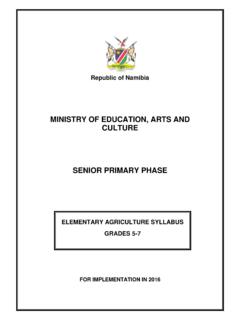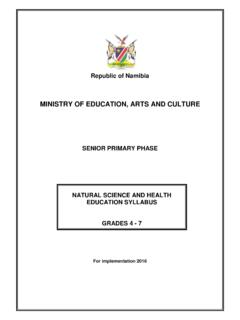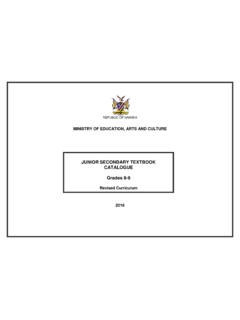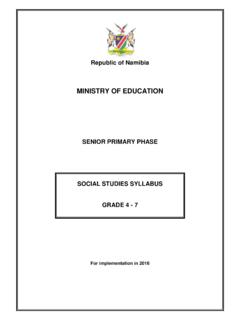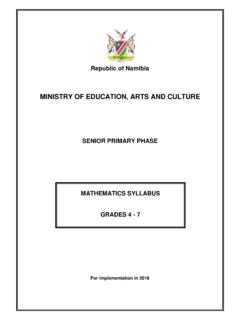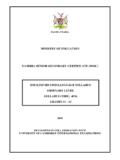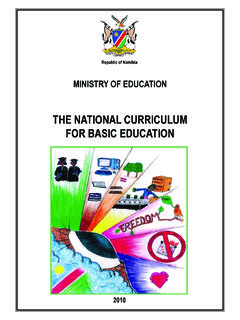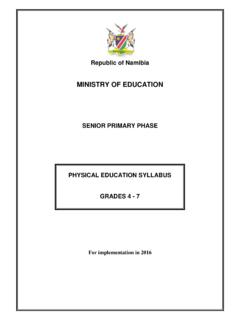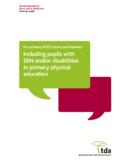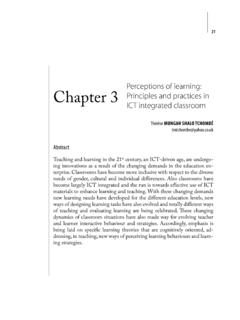Transcription of MINISTRY OF EDUCATION - nied.edu.na
1 Republic of Namibia MINISTRY OF EDUCATION SENIOR primary PHASE For implementation 2016 ARTS SYLLABUS GRADES 4-7 MINISTRY of EDUCATION National Institute for Educational Development (NIED) Private Bag 2034 Okahandja Namibia Copyright NIED, MINISTRY of EDUCATION , 2014 Arts Syllabus Grades 4 - 7 ISBN: 978-99945-2-090-9 Printed by NIED Website: Publication date: December 2014 Table of Contents 1. Introduction ..1 2. Rationale ..1 3. Aims ..2 4. Inclusive EDUCATION ..3 5. Links to other subjects and cross-curricular issues ..3 6. Approach to teaching and learning ..5 7. End of phase 8. Summary of the learning content ..6 9. Learning content ..8 10. Assessment .. 17 Introductory remarks.
2 17 Purpose of assessment .. 17 Types and methods of assessment .. 17 Grade Descriptors .. 18 Continuous Assessment: Detailed guidelines .. 19 Annexe 1: Glossary of terms .. 21 Annexe 2: Assessment record sheet for Grade 4 .. 30 Annexe 3: Assessment record sheet for Grades 5-7 .. 31 Arts syllabus, Grades 4-7, NIED 2014 1 1. Introduction This syllabus describes the intended learning and assessment for Arts in the Senior primary level. As a subject, Arts is within the aesthetic area of learning in the curriculum, but has thematic links to other subjects across the curriculum. Aesthetic This area includes learning to value and to communicate through the arts and to apply aesthetic qualities in other areas as well.
3 It involves sensory, emotional and intellectual experience, and not least creative thinking and activity. In Grade 4, three periods per week are allocated to Arts and the emphasis will be on craft work and music. In Grades 5-7 two periods per week are allocated to this subject. Under optimal circumstances, this subject would need two (2) undisrupted blocked periods per week. 2. Rationale Arts promote the holistic development, balanced growth, socialisation and development of the creative ability of a learner. The subject area is a means through which the process of unfolding, stimulating and capturing the learner's imagination and self-expression takes place. Through this subject area learners explore their inner selves, their environment, and make discoveries about communication through arts media.
4 An arts course should encourage personal expression, imagination, sensitivity, conceptual thinking, powers of observation, an analytical ability and practical attitudes. It should lead to greater understanding of the role of the visual arts in the history of civilizations; widen cultural horizons; and enrich the individual. In addition, it should combine a breadth and depth of study so that it may accommodate a wide range of abilities and individual resources. Arts complement literary, mathematical, scientific and factual subjects. It is especially concerned with the development of visual perception and aesthetics and is a form of communication and a means of expressing ideas and feelings. The Arts syllabus for the Senior primary Phase aims at building on the basic concepts of the arts without losing sight of the interconnectedness of activities, developing a spirit of enquiry and experimentation, fostering skills of observation and creativity, and reinforcing work in other areas of the curriculum.
5 The syllabus provides a broad experience-based arts curriculum for all learners. Arts support and enhance the skills needed in other subjects. One of the most fundamental modes of human learning is through play, imitation, music, movement and visual expression. Before they start school, learners will have a repertoire of acquired competencies, which when refined, become artistic expression. The areas where their acquired competencies are strongest will vary from learner to learner. Arts syllabus, Grades 4-7, NIED 2014 2 3. Aims Arts promote the following aims in the curriculum: develop the learners social responsibility towards other individuals, family life, the community and the nation as a whole; enable the learners to contribute to the development of culture in Namibia; promote wider inter-cultural understanding.
6 Technical aims include: developing skills in handling a variety of arts media; developing the ability to choose appropriate media for the task at hand; developing a sense of fulfilment in their own abilities to use media and technique; an appreciation of the technical abilities of other artists. Expressive aims include: developing the ability to express their own ideas, feelings and opinions visually and verbally; exploring the potential of various visual art media as avenues for personal expression; developing confidence in their individual powers of expression. Perceptual aims include: developing a sense of the aesthetic potential of the visual environment and an understanding of the possibilities for its artistic interpretation; developing the ability to transform visual arts media into individual responses to reality; demonstrating their understanding of visual, spatial and conceptual realities.
7 Appreciation aims include: attaining an understanding of the meaning and significance of visual art from their own and other cultures, both historical and contemporary and the contributions made by such work to the world today; being able to relate the work of other artists to their own artistic activity; using the art terminology with confidence when evaluating their own work and that of other artists. Arts EDUCATION promotes cultural awareness and appreciation by: stimulating the learner's imagination and creativity; encouraging self-expression, confidence and communication with others; fostering self-discipline, responsibility and cooperation; initiating the development of using the arts as a means of expression; enhancing problem-solving skills.
8 This syllabus is intended as a broad course exploring practical and critical/contextual work through a range of two-dimensional and/or three-dimensional processes. Where Arts as title or descriptor is used in this syllabus, it also encompasses new technologies in addition to traditional media and processes. It encourages candidates to develop: an ability to record from direct observation and personal experience; an ability to identify and solve problems in visual and/or other forms; creativity, visual awareness, critical and cultural understanding; an imaginative, creative and personal response; Arts syllabus, Grades 4-7, NIED 2014 3 confidence, enthusiasm and a sense of achievement in the practice of arts; growing independence in the refinement and development of ideas and personal outcomes; engagement and experimentation with a range of media, materials and techniques, including new media where appropriate.
9 Experience of working in relevant frameworks and exploration of manipulative skills necessary to form, compose and communicate in two and/or three dimensions; knowledge of a working vocabulary relevant to the subject and an interest in and critical awareness of other practitioners, environments and cultures; investigative, analytical, experimental, interpretative, practical, technical and expressive skills which aid effective and independent learning. 4. Inclusive EDUCATION During the Senior primary Phase all learners will be able to achieve more than a minimum level of competence, some will be able to do much more. A few learners will just be able to manage the minimum, and must receive support teaching through adapted materials, flexible approaches, assistance from peers and individual attention by the teacher.
10 A small number of learners may have special educational needs, which might require greater individual attention or resources. Some will have disabilities, which do not necessarily limit cognitive and affective learning and development, visual or hearing impairments or other physical challenged. The arts lend themselves especially well to developing perceptive and expressive skills in learners with special educational needs. Teaching, materials, and assessment for these learners will need to be more specifically adapted in inclusive classes. Intellectually gifted learners should be catered for through challenging activities and enrichment information. Extra work on the same level as that of other learners cannot be considered as enrichment activities.

